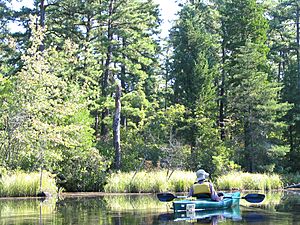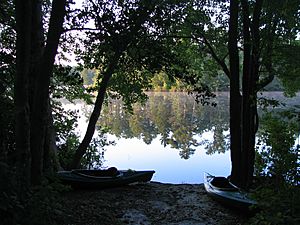Wharton State Forest facts for kids
Quick facts for kids Wharton State Forest |
|
|---|---|

Kayaking on the Mullica River
|
|
| Lua error in Module:Location_map at line 420: attempt to index field 'wikibase' (a nil value). | |
| Location | Burlington, Camden, and Atlantic counties |
| Area | 122,880-acre (497.3 km2) |
| Operated by | New Jersey Division of Parks and Forestry |
Wharton State Forest is the biggest state forest in New Jersey, a state in the United States. It covers about 122,880 acres (497 square kilometers) of the Pinelands. This huge forest is located northeast of Hammonton. It spreads across three counties: Burlington, Camden, and Atlantic.
Wharton State Forest is part of the New Jersey Pinelands National Reserve. It is also in the Atlantic coastal pine barrens area, which is a special natural region. The forest protects the land around the Mullica River. This river flows through the center of the Pinelands and empties into the Great Bay. The New Jersey Division of Parks and Forestry manages the forest.
The forest is home to the historic Batsto Village. This village was once a place where people made iron from "bog iron" (iron found in swamps) and also made glass. It operated from 1766 to 1867. Wharton State Forest has many hiking trails, including a part of the Batona Trail. This trail connects Wharton to other nearby forests like Brendan T. Byrne State Forest and Bass River State Forest. There are also over 500 miles (800 km) of unpaved roads. Rivers like the Mullica are popular for canoeing.
The forest is named after Joseph Wharton. He bought most of this land in the 1800s. Wharton wanted to use the groundwater from the Pine Barrens to provide clean drinking water for Philadelphia. However, New Jersey passed a law that stopped water from being sent out of the state. New Jersey bought the land from Wharton's family in the 1950s.
Forest History
In the 1800s, industries like iron making and paper mills grew in the New Jersey Pine Barrens. In 1873, a businessman from Philadelphia named Joseph Wharton started buying land and old towns in the Pine Barrens. He eventually owned about 100,000 acres (40,000 hectares). Wharton planned to build dams to send fresh water to Philadelphia. But in 1884, the New Jersey government passed a law that stopped water from being moved outside the state.
Joseph Wharton passed away in 1909. His family tried to sell his land to New Jersey for $1 million. However, people voted against this plan in 1915. For many years, a company managed the Wharton estate.
In the 1950s and 1960s, the government considered building a large jet airport in the Pine Barrens. To protect the land, the New Jersey government bought large parts of the Mullica River area in 1954. This land officially became Wharton State Forest on December 30, 1954. New Jersey bought more land in 1956, bringing the total to 96,000 acres (39,000 hectares) for $3 million. To stop more building, local people worked to save the Pine Barrens. This effort led to the creation of the Pinelands National Reserve in 1978.
Atsion Mansion Restoration
The Atsion Mansion is located inside Wharton State Forest. It was once a home and a place where cranberries were packed. The mansion has been empty since 1882. In 1960, its west porch was removed, making it look even older.
The State of New Jersey decided to restore the mansion. A company called Wu & Associates worked on the project. They removed the old outside plaster and put on new material. Inside, they fixed the plaster, wooden windows, and shutters. Fireplace mantels, stone floors, and wooden floors in the basement were all repaired. The cedar roof was also fixed. A new sidewalk was added outside, along with a ramp for visitors with disabilities. A new western porch was built to look exactly like the original one. The restored mansion now has electricity for lights and smoke detectors, making it safe for visitors.
Exploring Wharton State Forest
Inside the forest, you can find a monument to Emilio Carranza. He was a pilot from Mexico. On July 12, 1928, he crashed here while trying to fly his plane, the Mexico Excelsior, from New York to Mexico City. This was the last part of a special flight to the United States. Mexican schoolchildren donated money to build the monument. It shows a falling eagle in an Aztec style. Every year in July, on the Saturday closest to the crash date, people honor him at the monument. Representatives from Mexican consulates in New York City and Philadelphia also attend.
Wharton State Forest has ten campgrounds. Some, like Atsion Recreation Area, are for families. They have showers and a beach with lifeguards. Other campgrounds are for wilderness camping. You can only reach these by hiking or by canoe or kayak.
Apple Pie Hill is a popular spot for hikers on the Batona Trail. At the top of the hill, there is a 60-foot (18-meter) New Jersey Forest Fire Service fire tower. From the tower, you can see amazing views across the entire Pinelands region.



